Home
About us
News
Services
Guide Dogs
Vision Loss Resources
Discovery Centre
Conferences & Courses
Shop
Support Us
Contact Us
Eye Health
Structure and function
Optical illusions
Eye injuries
Foreign bodies
Chemical burns
Penetrating eye injury
Blunt trauma
Ultra violet damage
Eye disease and prevention
Diabetes
Eating for your eyes
Smoking
To learn more about keeping your eyes healthy, it is important to understand something of the structure of the eye and how it works. The design of the eye is amazingly complex and it seems we often take our eyes for granted.
MAKING YOUR WAY AROUND
All of the numbered EYE CONS are links to websites make sure you click on them and complete the whole journey.
Structure and Function
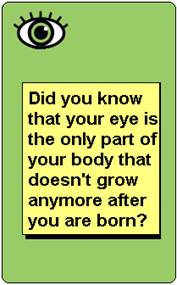
 In helping you to get to know more about your eyes and how they work, there are a number of activities you can complete on this web page.
In helping you to get to know more about your eyes and how they work, there are a number of activities you can complete on this web page.
As a starting point, visit St. Luke's Cataract & Laser Institute Copyright © 1996-2006 by clicking on the “Eye Con” 1 above. The site has an excellent diagram of the eye, its structures and their function. When you are done take the online QUIZ.
Now that you have taken the eye tour and have a little more idea about what goes on inside your eye, let’s take a look at the eye from the outside. This is a good exercise to do with a partner. Look at your partner’s eye and draw your own diagram of what you see. With the help of your teacher, identify and label the iris, pupil, sclera, eye lid and eye lashes. Once you are done you should write a brief description of the function of the eyelid, sclera and lashes. You can go back to the website to get help if you need it.
Now get your partner to close their eyes and count to 20. Look closely when your partner opens their eyes at what happens to the pupil and iris. Now let your partner observe what happens to your eyes using the same exercise. Why do you think your eyes behaved in this way? Write your answer along with a brief description of the function of the iris.
Optical Illusions
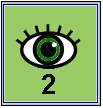 To help you learn more about how your eye works we can have some fun with optical illusions. Did you know that your eye is actually a part of your BRAIN! The Brain of course receives the information collected by your eye but it doesn’t always get it right. Take a look at these diagrams and see what your eyes make of them. You can try them on your friends too. Click on “Eye Con” 2
To help you learn more about how your eye works we can have some fun with optical illusions. Did you know that your eye is actually a part of your BRAIN! The Brain of course receives the information collected by your eye but it doesn’t always get it right. Take a look at these diagrams and see what your eyes make of them. You can try them on your friends too. Click on “Eye Con” 2
Eye Injuries
Your Eyes, as you know are soft, and while they are protected from most angles by the eye sockets in your skull, they are of course only protected by lids and lashes from the front. Most eye injury is of course accidental and often preventable. In this section we will be looking at common eye injuries and ways that we can protect our eyes.
Foreign Bodies
 All of you will have probably already experienced the most common eye injury at some stage in your life.
All of you will have probably already experienced the most common eye injury at some stage in your life.
Which of the following do you think it might be? Click the “Eye Con” 3 and see if you were right.
- Puncture wounds to the eye
- Burns to the eye surface
- Getting something in your eye
Tell your partner about a time when something like this happened to you.
What did you feel? How did your eye respond and how was the injury treated?
Getting something in your eye can be very painful; it always feels like the object is huge when most often it is tiny. Even when you get it out, sometimes the front of the eye has been scratched and stays painful. The sort of objects that get into your eyes in this way include things like dust, sand, insects, tiny pieces of material that splinter off something we might have been hitting, stones or even sticks.
We could come up with a long list I am sure but more importantly what can we do to prevent this kind of injury? In the workplace the most common way to prevent this kind of injury is to ensure that people working in areas of risk wear safety glasses or protective goggles. At home I am sure your parents don’t insist you wear safety glasses all the time so it is important to remember some simple things you shouldn’t do, like playing with sticks or throwing sand or stones will help keep your eyes safe.
![]()
REMEMBER Don’t rub your eye if you get something in it, this can cause scratches to the cornea and make the problem worse.
Chemical Burn
 The next eye injury we will talk about also happens when you get something in your eye. Apart from sand and other irritants common household chemicals can get into your eyes and cause chemical burns. Sounds serious, and of course it can be. Eye damage from some chemical burns can be permanent.
The next eye injury we will talk about also happens when you get something in your eye. Apart from sand and other irritants common household chemicals can get into your eyes and cause chemical burns. Sounds serious, and of course it can be. Eye damage from some chemical burns can be permanent.
Many of the chemicals around your own home can cause serious damage to your eyes. Click on the “Eye Con 4" and see if you can complete the chemical quiz.
HOW MIGHT CHEMICALS GET INTO YOUR EYES?
- Rubbing your eye can transfer chemicals from the skin on the hands to your eye.
- Chemicals can splash into your eyes when you are pouring them
- They can also spray into your eye from aerosol or pump action cans and bottles.
PREVENTION
- Wash Hands after using any household chemicals
- Read instructions carefully before using
- Turn spray nozzles away from your face and the faces of others.
- Keep dangerous substances properly stored in a secure area out of the reach of small children.
![]()
REMEMBER If you get Chemicals in your eyes wash them out immediately then get help. While some eye injuries can be easily treated, more serious injuries like those listed below will require medical treatment.
Penetrating Eye Injury
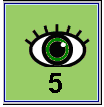
A Penetrating eye injury occurs when an object punctures the eye itself; as you can imagine such an injury can lead to blindness. Not surprisingly there are many hazards around the house and at school that can cause such injuries. Click on the “Eye Con” 5 and see if you can sort out the list of dangers.
![]()
REMEMBER Never play with sharp objects that might puncture the eye.
Blunt Trauma
 Blunt Trauma means that the injury was caused by a blunt rather than a sharp object. The most common form of blunt trauma is the “Black Eye”. You may have had one yourself. Tell your partner how it happened. I bet they have a story to tell as well.
Blunt Trauma means that the injury was caused by a blunt rather than a sharp object. The most common form of blunt trauma is the “Black Eye”. You may have had one yourself. Tell your partner how it happened. I bet they have a story to tell as well.
Most Blunt Trauma injuries happen when people are playing sport which might surprise you. Bats, balls boots, knees, elbows and other player’s heads can all cause such injuries. Click on “Eye Con" 6 and see what can happen when a baseball meets an eye.
This kind of injury can cause rupture of the eye and bleeding inside the eye, both of which can lead to visual damage. Blood in the eye can block the light getting into the eye and prevent a person seeing. If the blood settles in the vitreous humor it can remain there and cause a long term obstruction to vision. A more common problem associated with bleeding or rupturing of the eye is bleeding under the retina. This can cause the retina to detach (lift off) from the back of the eye.
![]() REMEMBER Always take care when playing sport or rough and tumble games with your friends. If the sporting activity you are participating in requires that you wear protective helmets or goggles, make sure you do.
REMEMBER Always take care when playing sport or rough and tumble games with your friends. If the sporting activity you are participating in requires that you wear protective helmets or goggles, make sure you do.
Ultra Violet Damage

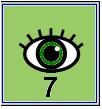 Just like your skin can get sunburned by ultraviolet light emitted by the sun, the eye surface, particularly the Cornea, can also be burned. A bad burn of this kind can cause permanent eye damage. The Retina too can be burned with equally disastrous results for your eye sight.
Just like your skin can get sunburned by ultraviolet light emitted by the sun, the eye surface, particularly the Cornea, can also be burned. A bad burn of this kind can cause permanent eye damage. The Retina too can be burned with equally disastrous results for your eye sight.
Over time too, working outdoors in the sun without protection for your eyes can cause cataracts to form in the lens of your eye. A cataract causes gradual clouding of the lens which can eventually become so cloudy you can no longer see through the lens.
While looking at the sun directly is dangerous, sunlight, particularly the ultra violet light can reflect off snow and water and cause damage to the eyes. Sun glasses and skiing goggles are recommended to protect your eyes in these situations.
Apart from the sun, ultra violet light is emitted by sunlamps the lights in a tanning booth and welding equipment. All of these pieces of equipment should be used with care and the correct safety goggles worn.
![]() Light from the sun and other ultra violet light sources can cause permanent damage to your eyes. So make sure you wear protective goggles or sunglasses in situations where you are exposed to ultra violet light.
Light from the sun and other ultra violet light sources can cause permanent damage to your eyes. So make sure you wear protective goggles or sunglasses in situations where you are exposed to ultra violet light.
 Take a moment to review the various types of eye injury and then enter the Ghastly Gallery by clicking on “Eye Con” 7. In the Gallery you will find some pictures of eye injuries from some of the five categories we have discussed. See if you can match the injury with the cause category.
Take a moment to review the various types of eye injury and then enter the Ghastly Gallery by clicking on “Eye Con” 7. In the Gallery you will find some pictures of eye injuries from some of the five categories we have discussed. See if you can match the injury with the cause category.
Eye Disease and Prevention
There are many different types of eye disease and we certainly don’t have room here to discuss them all. Instead we will look at those that are “preventable”. This section will help you to understand the importance of protecting your eyes and maintaining a good diet which will hopefully, help you to make good decisions and prevent these diseases happening to you.
There are quite a few medical words in the following section. If you are not familiar with a medical word, click on “Eye con” 8 below and check the glossary.
Diabetes
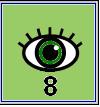 Diabetes is probably the most common cause of eye disease. It affects older people mostly but you need to remember that older people were young people like you once and their lifetime eating habits may well have lead to the development of this disease in later life. By learning about good diet and eating good foods you can do a lot to make sure that your eyesight is good for your whole life, not just some of it.
Diabetes is probably the most common cause of eye disease. It affects older people mostly but you need to remember that older people were young people like you once and their lifetime eating habits may well have lead to the development of this disease in later life. By learning about good diet and eating good foods you can do a lot to make sure that your eyesight is good for your whole life, not just some of it.
In simple terms Diabetes is a disease that affects your body’s ability to use the sugars your body absorbs from the food you eat. Sugars, complex and simple, provide fuel for our body’s cells and we would quickly die without them. If the body can not absorb sugars properly then you can imagine your body is not going to work well.
If your body’s cells can not absorb the sugars in your blood then the level of sugar increases. Over time this “higher than normal” blood sugar level causes damage to your blood vessels and here is where the problems start for your eye.
There are several different types of eye problems associated with diabetes such as glaucoma, cataracts, retinopathy, and vitreous hemorrhages. All of which can lead to blindness.
Eating for Your Eyes
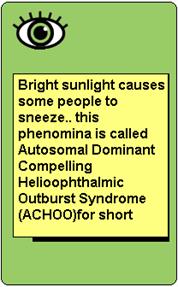
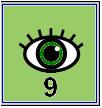 Good nutrition is very important for both your general and eye health. Good nutrition helps our body to grow, repair wear and tear, protect against infection and to function properly.
Good nutrition is very important for both your general and eye health. Good nutrition helps our body to grow, repair wear and tear, protect against infection and to function properly.
Many of the foods that are good for your eyes are rich in Vitamin A. Click on “Eye Con” 9 and use the oval drawing tool to complete the word search for these foods.
Before we move on from eating another related problem which may lead to eye disease is obesity. Obesity significantly increases the risk of developing diabetes and the associated eye diseases we have already discussed. Not only do we need to watch what kinds of foods we eat we also need to monitor how MUCH we eat.
Smoking
 Smoking has a direct effect on eyesight because, like diabetes, smoking affects the blood vessels that supply blood to our organs. Narrowing or blockage of the fine blood vessels in the eye can lead to the formation of cataracts and degeneration of the Macula as we age. Smoking reduces appetite too, people who smoke often have poor diets as a result and we have already discovered how this can have a negative affect on our eyesight.
Smoking has a direct effect on eyesight because, like diabetes, smoking affects the blood vessels that supply blood to our organs. Narrowing or blockage of the fine blood vessels in the eye can lead to the formation of cataracts and degeneration of the Macula as we age. Smoking reduces appetite too, people who smoke often have poor diets as a result and we have already discovered how this can have a negative affect on our eyesight.
Click on “Eye Con” 10 to find out more about Macula degeneration and see how the world might look for someone with macula degeneration. © Macula Degeneration Foundation Fact Sheet



